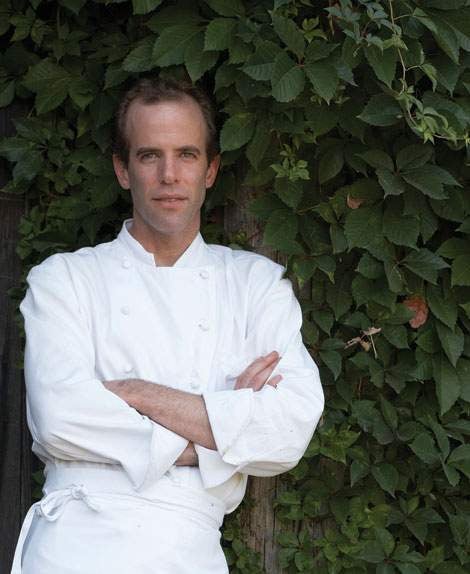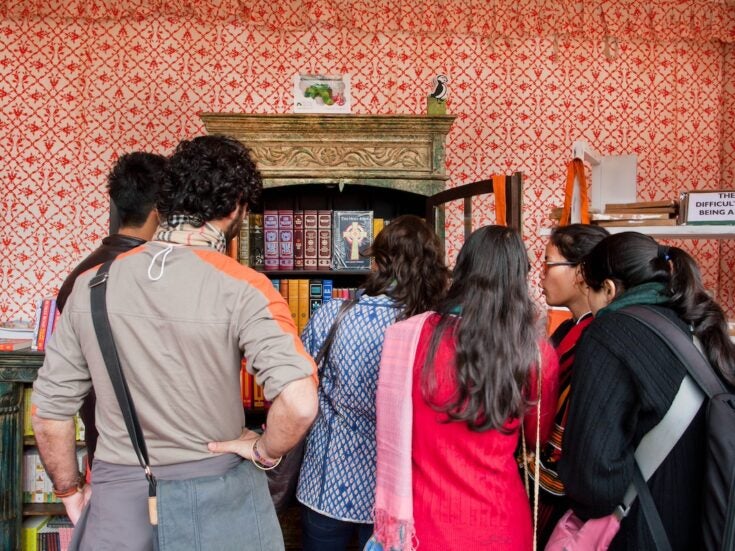
Not far from New York City, chef Dan Barber is cultivating a revolution with farming and local produce at its heart
Photos by Susie Cushner, Jen Munkvold & Thomas Delhemmes
A 40-minute train ride north of Manhattan’s refrigerant-pumped supermarkets, with their miles of aisles of bland cheese, unnervingly peroxide-white milk and poultry stamped with the mouth-watering promise ‘antibiotic-free’, stands the grand, bucolic Stone Barns Center for Food & Agriculture. Back in the 1930s this was the private dairy for the Rockefellers, a rural idyll close to the city and a stone’s throw from their Pocantico Hills mansion. In 2003 the family donated it to its current residents, with a view to farm preservation and research. A year later, Blue Hill opened inside one of the barns — a restaurant that would become one of the most radical in America.
Blue Hill chef Dan Barber doesn’t send wait staff from his kitchen bearing plates of spherified ingredients trailing plumes of fragranced dry ice. Instead, they come with bouquets of prosaic asparagus — a ‘before’ illustration of the cooked dish that will come later. It’s a tiny vignette in a dining experience that can take five hours. This is ‘farm to table’ dining pushed further than you ever thought possible, with industry-changing consequences.
Barber is a man on a mission, aiming to reboot the way America sees food — and eats. His kitchen is innovative, but it’s the R&D in his farm that put his restaurant — belatedly, many believe — into the World’s 50 Best Restaurants for 2015, and which made the documentary on him the standout film in the recent six-part Netflix series Chef’s Table.
‘For me, it always comes back to flavour,’ says Barber. ‘We are continuing to explore how flavour is created, not just in the kitchen, but in the field and pasture. It’s not just how to grow the tastiest carrot, but how can I grow the best soil? How can I support the kinds of ecological relationships that yield the most delicious, nutritious food?’

Of all the developed nations, the USA — where you can buy a gun at Kmart but Roquefort is illegal — has one of the most notorious diets, and not just in terms of Fast Food Nation-style exposés of unscrupulous farming and E. coli. Decades ago, the inimitable oracle of food at Condé Nast, Jeffrey Steingarten, began filling American Vogue’s pages with tales of culinary wonderment in Europe and Asia, and the disappointment he felt when faced with grocery stores back home.
Today, a glance at the homepages of popular websites Grub Street or Eater NY creates a snapshot of a puerile obsession with pizza, French fries, burgers and whatever twist TV chef David Chang has given to fried chicken this month.
Barber is doing something different. He believes the American diet is absurdly meat-centric and unsustainable (‘vegetable forward’ is the hot new buzz term in the progressive food community), and recently he staged ‘wastED’, a pop-up at his Greenwich Village offshoot restaurant that explored how to re-use and consume the food waste that results from a tasting menu. ‘From now on,’ wrote Pete Wells in the New York Times after visiting, ‘when one of my children complains about dinner, I’ll silence him by saying that I once ate garbage, and I liked it.’

Barber hopes that what he’s doing at Stone Barns will influence and repair a broken industry that’s big on food miles and low on quality. ‘In the last 50 years, we’ve lost a lot of the infrastructure — things like local slaughterhouses — that make a regional supply chain viable,’ he says. ‘Right now, there’s a huge demand for local grains in the city, and a growing number of New York state farmers willing to meet it. But we still need more proper grain drying and storage facilities, and mills, and seed companies.’
One of his most famous innovations is ‘Barber Wheat’. In the quest for the ultimate bread, Barber worked with Dr Stephen Jones, founder of the Bread Lab at Washington State University, to cross-pollinate wheat that could be grown at Stone Barns for the most delicious, dark, whole-grain bread imaginable. When it comes to your table at Blue Hill at Stone Barns, sensibly towards the end of the 30 or so courses, it’s a delight.
Barber’s latest discovery is similarly carb-based. ‘We built a bakery within the restaurant a few months ago,’ he says. ‘The goal was to ramp up bread production for our two restaurants, but also to use it as an experiment station for whole-grain baking. The other day our baker brought me a 100 per cent whole-wheat pain au levain made with a new variety of wheat. It was a delicious “Aha!” moment.’
After perfecting the sweetest Mokum carrot and the most radishy radish ever, Barber is trying to infuse flavour into hybrid celery-lettuce plants — celtuce — by planting them with nut press cake, and is working on the ultimate egg. ‘The yolks I had on my last visit to Italy were electric orange,’ he says. ‘I’ve never seen anything like it. I am obsessed with reproducing them.’

For all the 21st-century industrial revolution proposed in Barber’s 2014 book The Third Plate: Field Notes on the Future of Food (‘A must read’ — Al Gore), which details his belief in eating only what your immediate environment can comfortably supply, as well as his admiration for the naturally sustainable dehesa system of farming in Spain, Barber’s rise to fame is largely attributable to the revelatory Blue Hill at Stone Barns experience.
‘I want people to experience the connection between the ingredients on their plates and the landscape that produced it,’ says Barber. ‘We agonise over the pacing of the meal, the perfect number of dishes and the sequence of tastes.’
It’s literally a journey: you arrive upstate, explore some of the six acres of absurdly picturesque farm, then take your table at around 6pm. There’s no menu, just a constant flow of fresh, light, vegetable-forward dishes — elderflower sprigs in tempura batter, and the first baby cucumber of the season. But there are also cherries encased in lardo, Stone Barns pork (a nose-to-tail arrangement — belly, snout and blood sausage) and surprises: you may be relocated for a single course to what was once the manure shed, now a romantic den full of candles and flora, where a ‘pizza’ of potato, mushroom and grated egg is served, after being cooked sous-vide in the compost heap. Then there’s a red beet hot dog on the terrace. Then it’s back inside for more…
And behind all the consciousness-raising, fun, games and degustation, there’s Barber in the kitchen, the constantly turning engine. ‘We’re having a great evening,’ says one guest en route for a course with a ringside view of the chef at work. ‘Thank you, thank you,’ says Barber, shaking their hand graciously, looking utterly exhausted as he tends to several pots in front of him, with hours of work ahead, two restaurants to tend to and no day off in sight.
In a world where chefs are known for working all the hours in the day, one wonders if Barber — who has become the figurehead for a whole food movement and a potential revolution — sleeps at all.







